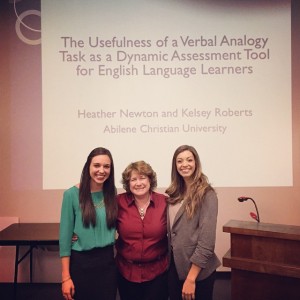What are you doing?
I am working with Pearson Education, Inc. to design a special language assessment tool to be utilized with children who are English language learners (ELLS) and who are suspected of having a language/learning disability. The type of assessment is called a “dynamic assessment”; it is intended to measure a child’s capacity to learn a new language-based skill during a brief, interactive (dynamic) teaching session.
Whereas a traditional language test checks what a child knows and does not know in different language areas, and then computes a score, this type of assessment tool will look at a quality called “modifiability,” (how easily can the child change and learn). It will also measure the amount of effort and time it takes to teach the skill to a particular child. Once completed, the measure should be able to compare the data collected on a specific client to a database of results from children who are typical English language learners. Current literature indicates that this type of measure can help identify those who are struggling with learning the new language due to a disability rather than a language difference stemming from having a diverse language background.
 My graduate student researchers and I have developed two of the three projected tasks for the assessment, and designed an assessment protocol and procedural guide. We also have created a “mock-up” of the interactive teaching activities to be used (all the materials will eventually be available on a digital platform; likely a web-based application). We have collected research data on whether or not the dynamic assessment tool is effective at facilitating and measuring change in some English skills for these children–and the data so far indicates that it is! The tasks are now being sent out to speech-language pathologists in the field for their feedback.
My graduate student researchers and I have developed two of the three projected tasks for the assessment, and designed an assessment protocol and procedural guide. We also have created a “mock-up” of the interactive teaching activities to be used (all the materials will eventually be available on a digital platform; likely a web-based application). We have collected research data on whether or not the dynamic assessment tool is effective at facilitating and measuring change in some English skills for these children–and the data so far indicates that it is! The tasks are now being sent out to speech-language pathologists in the field for their feedback.
Why are you doing it?
One of my primary teaching and research interests, and an area in which I continue to practice as a speech-language pathology consultant, is in the area of service delivery to individuals who have diverse cultural and language backgrounds (CLD). We have a history in Texas and in the US of over-identifying language disabilities in the CLD population, and that is a discriminatory practice (although accidental!).
It is very difficult for speech and language pathologists to test children in this country who are learning to speak English, and do so in a way that is language–and culture–fair. Obviously, English language learners do not yet speak English fluently, so our typical speech and language tests don’t work for them. Furthermore, it is often impossible to find assessment tool in these children’s home languages (L1). For this reason, we need reasonable ways to look at what they are able to do with the English they have learned, and decide if they are showing adequate language-learing skills.
English language learners are often referred by physicians, teachers and others for speech and language assessment; we must have assessment strategies that are supported by research to effectively assess speakers with limited English skills. I’m excited about developing an assessment tool that can hopefully be used with speakers from a variety of language backgrounds to provide more accurate speech and language diagnoses for them!
Why do you think its important to incorporate this practice into the classroom?
Undergraduate and graduate students who are studying speech and language pathology need to understand the scope of this problem–that of over-identifying English language learners as having language disabilities when actually they don’t. Our population in Texas and in the US is growing ever more diverse, and all speech-language pathologists in the future will need to know how to appropriately work with these populations. I think that participating in this research has helped my graduate students be much more thoughtful in how they approach language assessment–I know that those on my team are very well equipped to assess ELLS!
In the undergraduate classroom, I introduce students to the topic of dynamic assessment for ELLS as an example of an appropriate alternative assessment strategy, so that as they move through the rest of their professional preparation they are alerted to and aware of the idea of culture-fair assessment (which is an area that is not away thoroughly addressed in graduate speech pathology programs).
Who is being impacted the most?
Right now I believe that graduate students in our program are those who are most impacted, as they learn how to design and conduct alternative assessments for ELLS. However, I think ultimately the children for whom this measure is designed will be the most impacted, as this should increase diagnosis accuracy for young ELLS begin tested for language disabilities.
What hopes do you have for the future when this work is done?
Our hope is that this assessment tool will be made available to SLPS throughout the country as a web-based application. The current project addresses ELLS who are between 6-8 years of age; we are in the process of considering dynamic assessment tasks for older children as well.
